For two years, ‘Daisy’, our venerable 4×4, has served us well. She was bought second-hand in Milton Keynes and – having left the concrete cows and urban utopianism – survived the Ukrainian frontline unscathed. Until now.
Between the first and 15th high-explosive rounds fired by the T-80 tank with which we are sharing a maple thicket, Daisy’s windscreen cracks from one side to the other, her rear-view mirror falls from its mount, and all the storage pockets in her ceiling lining burst open. Such is the proximity to stupendous firepower.
The shockwaves are like slaps of hot air. Green leaves, not due to fall for months, are torn from branches. Dust and smoke intermingle.
The forest is filled with ear-piercing sound as a second tank – close but invisible – also opens fire over our heads.
‘F****** good!’ enthuses the Ukrainian drone pilot who is spotting the fall of the shells, aimed at a Russian infantry position some miles away. His corrections come over the tank crew’s walkie-talkie.
The fifth round of the fire mission detonates on the enemy trench-line. The order changes to ‘fire for effect’. In other words, keep hitting that spot. Kill them all.
And now comes payback.
Through the cacophony of outgoing rounds, we hear the staccato bleeps of the drone detector at the entrance to the tankers’ dugout.
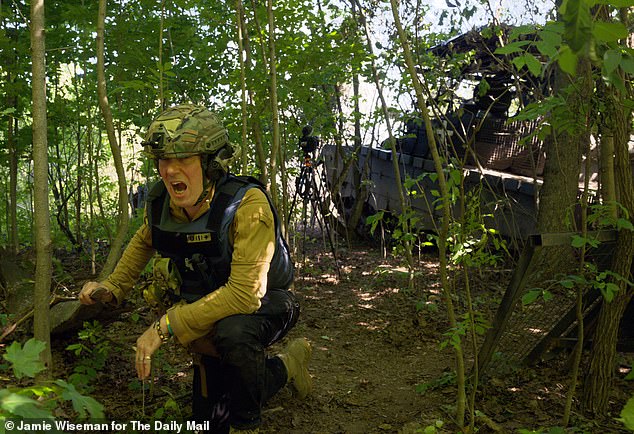
Richard Pendlebury reacts as tanks fire on the Sumy frontline in Eastern Ukraine
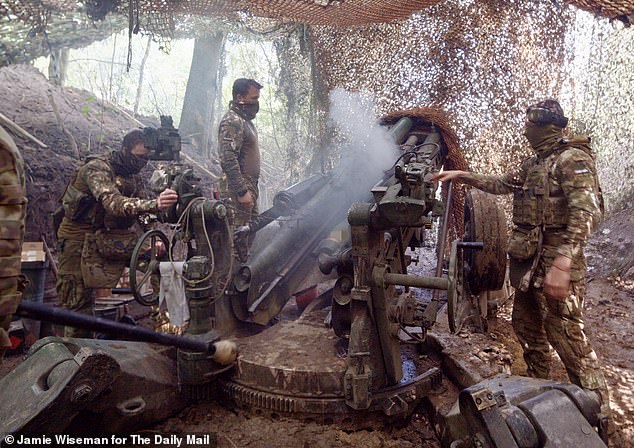
A British designed M777 howitzer artillery gun operated by the SAS-style Kraken Regiment
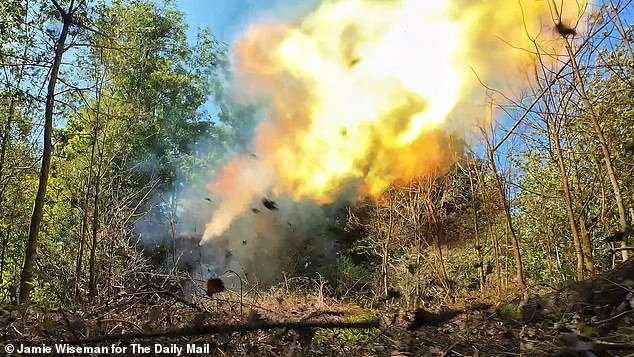
A T-80 Tank, captured intact from the Russians and operated by the Kraken Regiment, in action
A Russian Zala UAV is back above the tree canopy, hunting for the guns in what is likely to be a day-long ‘game’ of hide and seek.
The crews pause their fire, lest they betray their positions – as they will, disastrously, a few days later.
But, at the moment, we can hear the buzzing of insects rather than drones.
Because this is also a lovely summer’s afternoon. Twenty miles to the south-west, girls are promenading in cotton dresses, and you can still eat sushi in an air-conditioned shopping mall.
Yet up here, in the forested hillsides, the battle for Sumy rages on.
Last August, Ukraine launched an unexpected and audacious ground offensive across its northern border, from Sumy into the Russian region of Kursk.
Fierce fighting – and embarrassment for Russia’s president Vladimir Putin – continued until March this year when a massive concentration of forces and firepower pushed the Ukrainian interlopers back across the frontier.
The Russians kept pushing. Now combat is taking place several miles inside Sumy, where the Russians last had a foothold in 2022 as they drove towards the capital Kyiv.
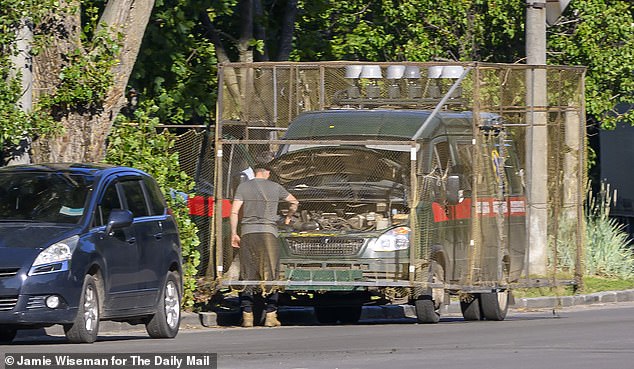
Vehicles on the Sumy front are protected with rudimentary nets to protect from drone strikes
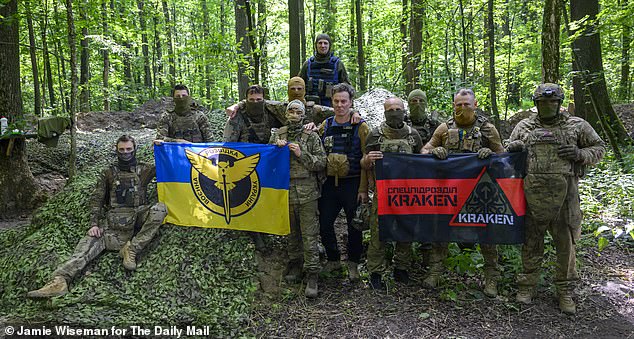
The Kraken Regiment are a special forces arm of the Main Directorate of Intelligence of the Ministry of Defence (HUR)
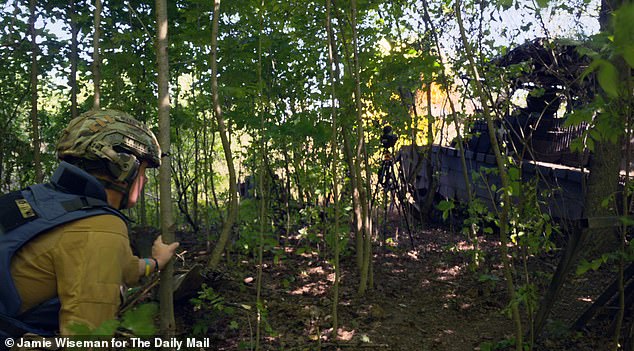
Richard peeks through a maple thicket between the first and 15th high-explosive rounds fired by the T-80 tank
In June, Putin remarked that taking Sumy oblast wasn’t one of his war aims. But, as the US threatens further sanctions on Russia and Putin continues to snub Ukraine’s President Volodymyr Zelensky, that could all change.
The Sumy village of Andriivka has swapped hands twice already this summer. British volunteer Ben Burgess, an FPV drone pilot, was killed in its defence in June.
A few miles east of Andriivka lies the strategic hilltop settlement of Yunakivka.
If that is taken, the Russians will be within long-range artillery fire of those shopping malls of Sumy city, which has a population of 250,000 and narrowly escaped occupation in 2022.
Both sides have committed some of their best units to the fight. One of the formations standing in the way of this Russian offensive is the Kraken Regiment: a special forces arm of the Main Directorate of Intelligence of the Ministry of Defence (HUR).
Named after the mythical sea monster, Kraken is renowned for SAS-style raids behind enemy lines as well as its old-fashioned ‘earth-moving’ equipment.
Over several days last month, Daily Mail photographer Jamie Wiseman and I were hosted by a Kraken tank platoon and a heavy artillery battery.
Such artillery and the battlefield-dominating attack drones have stalled the Russian advance into Ukraine’s heartland along the frontline closest to Kyiv.
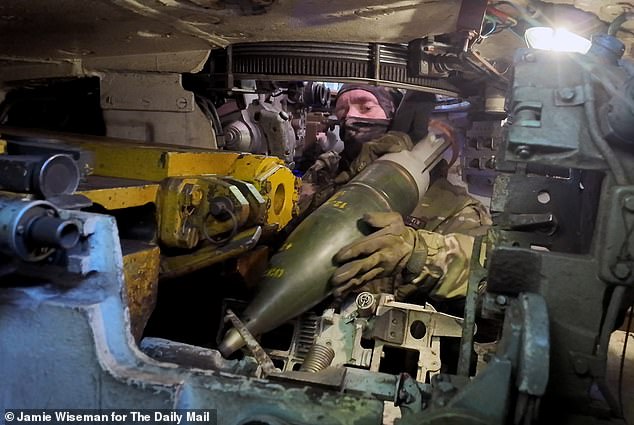
Tank Operator Mikail, who was dragged from his burning tank last week after this position was hit by a Russian strike
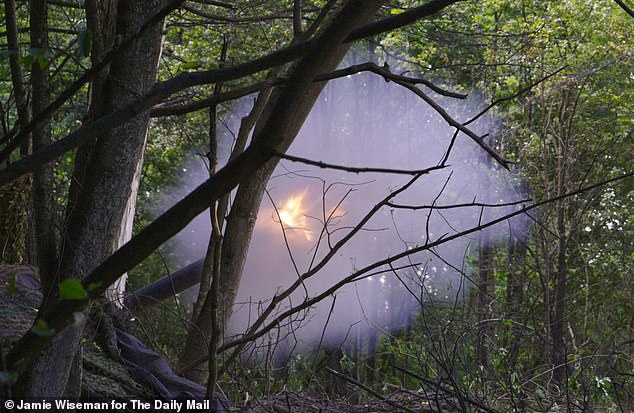
Gunfire and smoke fill the air as a British designed M777 howitzer artillery gun is operated by the Kraken Regiment
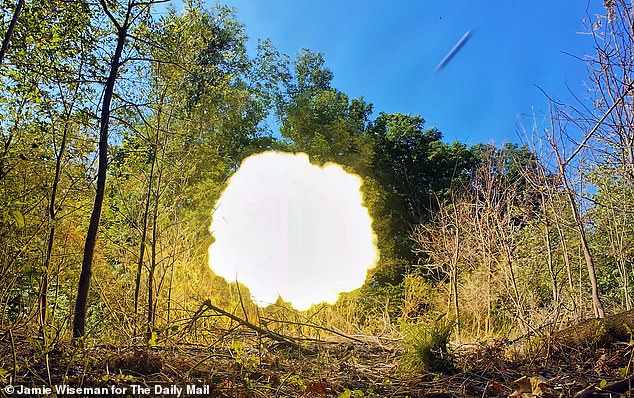
A projectile is fired by a T-80 Tank, which has been captured intact from the Russians
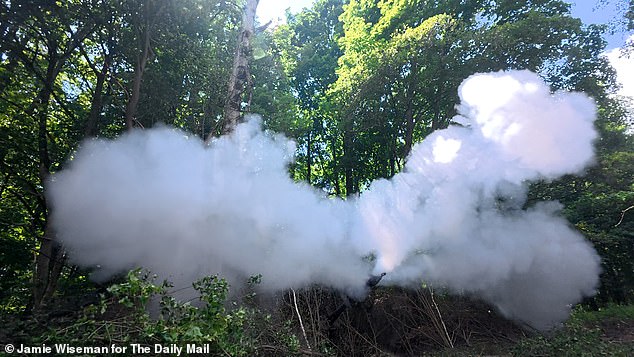
Combat is taking place several miles inside Sumy, where the Russians last had a foothold in 2022 as they drove towards the capital Kyiv
And that is why the enemy’s hunt for Ukraine’s big guns and gun crews is relentless.
Deep in the forest, what appears to be a British artillery team is preparing for action: The Ukrainian gunners are wearing donated British Army camo fatigues.
Some still have the Union Flag sewn on their sleeves. Their gun is also British.
The M777 howitzer was designed in Cumbria by Vickers, before the historic company was absorbed into what is now BAE Systems.
In November last year, BAE announced that it would be opening a new factory in Sheffield to boost M777 production.
Such is the demand caused by the Ukraine war. ‘You are good allies,’ says one of the gunners, a former actor whose call-sign is ‘Nick’.
Weighing more than four tons and able to throw a 45kg shell more than 20 miles, the Cumbrian howitzer squats huge and sinister in a heavily camouflaged, earth-walled gun pit.
Only when it’s ready to fire will the snout of its barrel emerge from hiding beneath netting and foliage. There are too many Russian drones on the prowl for it to lie in the sunshine.

Weighing more than four tons and able to throw a 45kg shell more than 20 miles, the Cumbrian howitzer squats huge and sinister in a heavily camouflaged, earth-walled gun pit
The crew receive coordinates for a new fire mission. They begin to go to work.
Aside from digital aiming aids and some other automation, little has altered in the physical preparation of what Wilfred Owen described during the Great War as the ‘monstrous anger’.
We watch as the trajectory and direction of the howitzer are altered by the spin of wheels.
Two other gunners are screwing fuse caps into shells and carrying them to the pit. The next shell is placed in the breach.
A white sack of propellent gunpowder is secured behind it and then a gunner wielding a long, kinked ramrod thrusts the whole package into place.
Another artilleryman is holding a long rope called a lanyard. He waits. Then comes the order – Postril! (shoot) – and he steps away and yanks the rope.
KA-POW.
I am crouched with my back against the wall of the gun pit with my mouth open and ear protectors in place, and still the shock is astounding.
Clods of earth tumble, smoke swirls and there is a sulphurous smell. Blithely, the team begin to reload.

Even from some distance away, the shockwaves of Howitzer munitions race through the zigzag trench into the dugout and up the steps at the far side
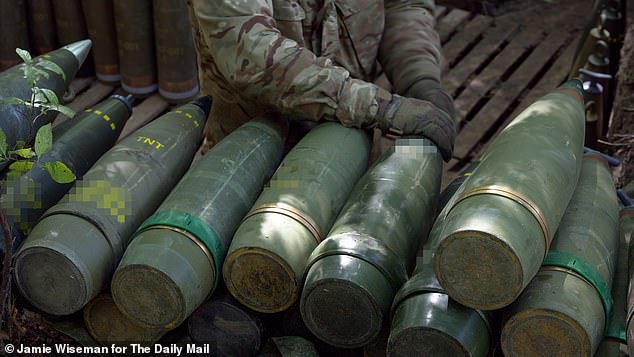
The M777 howitzer was designed in Cumbria by Vickers, before the historic company was absorbed into what is now BAE Systems
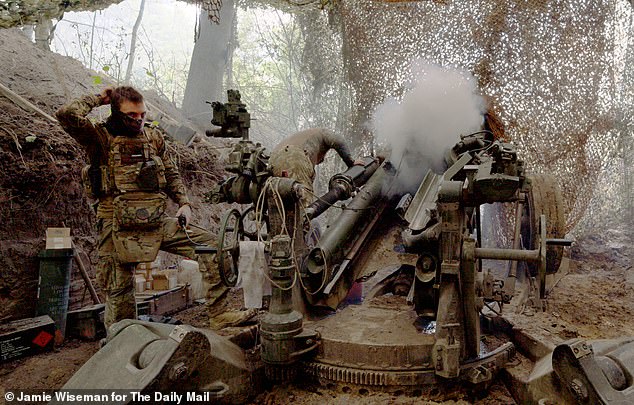
The crew prepare for the day ahead and ensure their M777 howitzer artillery gun is ready
Apparently, the concussion is more impactful where I am, a few yards away, than if crouched over the breach.
Two more thunderous discharges, then a pause. There is a problem with the automation. There will be a delay as mechanics come up from the rear to fix the gun.
During the hiatus, I’m shown the dugout which can sleep eight.
It has two entrances. One leads directly to the gun, the other in the opposite direction. Or, as one of the gunners explains: ‘That way to the Russians, the other way to normal people.’
In the dugout there is Korean kimchi, black bread and salo – salt-cured pork fat. ‘We are not rich but we live like kings,’ says ‘Anthony’, another gunner, with only mild irony.
Their gun fixed, the firing resumes. After the seventh round it falls silent again. More ammunition is needed. It will be brought up shortly in an armoured vehicle.
As we wait, other howitzers are firing. Even from some distance away, their shockwaves race through the zigzag trench into the dugout and up the steps at the far side.
Then another Zala is detected, and we retreat underground again.
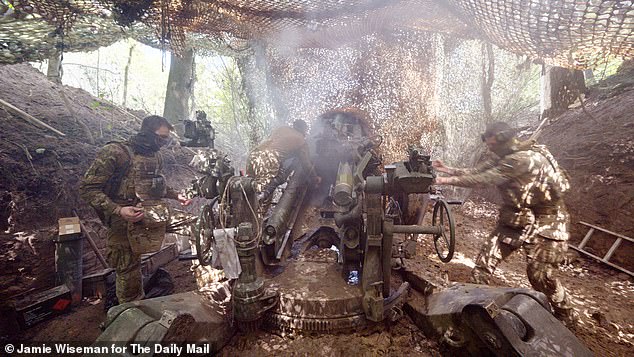
The M777 howitzer was designed in Cumbria by Vickers, before the historic company was absorbed into what is now BAE Systems
Eventually, an engine can be heard approaching. An MRAP armoured vehicle appears and stops.
The rear doors are opened, and we see it’s loaded from floor to roof with shells.
The howitzer crew form a human chain and, within five minutes, dozens of the rounds are unloaded. They can work again.
The gun crashes. Between 30 and 60 seconds later, the shell will impact, depending on the size of the propellant. On the screen in the dugout, the target is a low, white building in the sunshine.
The first five shots fall long, short or wide. The final two are direct hits. Cease fire.
The sun is still an egg yolk orange smudge on the horizon and the fields beside the road are swathed in mist. What doesn’t change day or night is the crash of artillery fire.
Once again, we’ve had to set off before dawn to reach a position in the ‘kill zone’ before the drone threat becomes severe.
But this is also when one sees more of the wildlife that shares the forest with the war. Nesting storks are silhouetted against the brightening sky and, at 5.30am, a deer runs ahead of our vehicle along a logging track, before coming to its senses and veering off into the undergrowth.
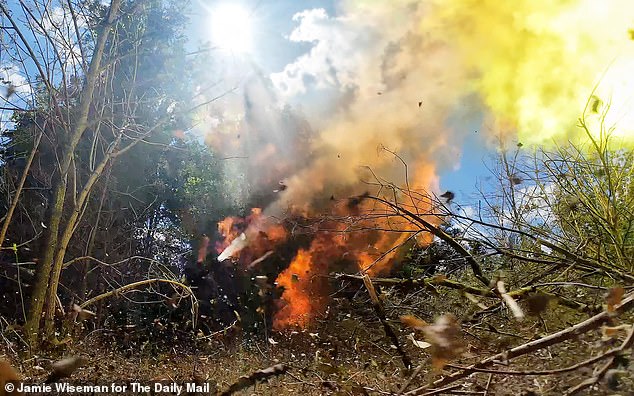
Equipped with a gas turbine rather than a diesel engine, the T-80 was noted for its high speed
After several miles we do the same. Two Ukrainian soldiers step out of the forest.
They turn and lift enough foliage and anti-drone netting to create a gap large enough for Daisy and our military escort to drive through.
The screen, natural and artificial, is then dropped back into place behind us. Like the deer, we have disappeared into cover.
In the semi-darkness of a dense thicket on the edge of a combe, we find a Kraken crew is preparing for the day.
They have a rudimentary dugout with room to sleep three and little more. But where is their tank? They laugh and beckon.
Huge – more than 40 tons – the T-80 is almost invisible from all but a few yards away, due to the foliage, camouflage netting and poor light.
Equipped with a gas turbine rather than a diesel engine, the T-80 was noted for its high speed.
Under Soviet doctrine it was designed to reach the English Channel coast in five days of Hot War Blitzkrieg.
This T-80 is an export version, built for the Greek army in the 1990s but never delivered.
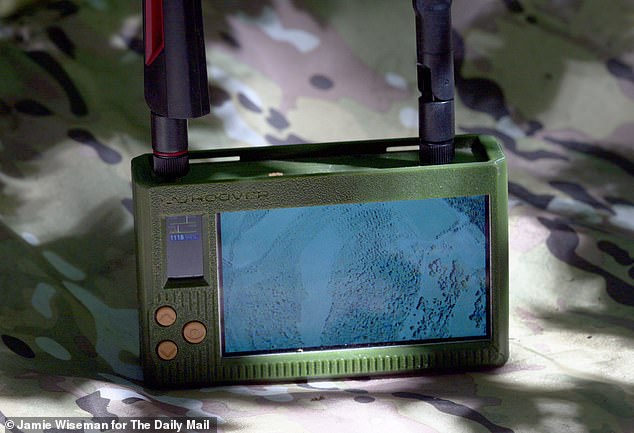
A drone detector used by the Ukrainian army to help combat incoming Russian missiles
It took part in the Russian invasion of Ukraine, was captured intact – a ‘trophy’ – and is now being used against its former comrades.
But, in this drone and missile dominated conflict, massed armoured assaults are increasingly rare.
Tank-on-tank combat is as frequently seen as unicorns. The Kraken crew has not fired armoured piercing rounds in combat. Their job is largely static.
The tank has been dug in so that the front end and, more importantly, the 125mm cannon is unusually elevated.
It’s being used as an artillery piece, for indirect rather than direct fire, lobbing high explosives at troop concentrations.
There are the customary instructions. If there is counter-battery fire and one hears the instruction ‘Zemlia’, you put your face in the dirt. Not down on one knee. The Russians have been using cluster munition.
And, if a drone should wander up the forest track, descend into the dugout or hug a tree. Just make yourself invisible.
At 6.10am an order comes through. The three crew men climb into the T-80 and ‘start work’ at once.
Crack. Whoosh. Then the clank of the autoloader as another shell is placed in the breach.
Other projectiles are flying along the wooded valley at supersonic speed. An unidentified drone comes past at 7.15am but it’s probably a Ukrainian Vampire heavy bomber, as such a unit is operating nearby.
A Russian Zala is detected, but many kilometres away. Then another one, closer.
At 9.41am there are bursts of gunfire from across the valley, which suggest a Russian drone.
Then a loud explosion which doesn’t sound like outgoing. Probably an incoming detonation.
Meanwhile, vehicles are racing up and down the track beside the thicket. Humvees with enormous cope cages or all-terrain buggies with skeletal tubular structure driven by special forces.
At 10.39am there are a series of tremendous explosions. ‘Oh, a KAB,’ exclaims the 50-year-old tank commander whose call-sign is ‘Mikhalych’.
These are the Russian glide bombs which have done so much damage.
Then, briefly, silence.
Your ears tell you the forested slopes are filled with busy artillery positions and drone pilots. Your eyes say otherwise. This is nature’s camouflage. Bumblebees sound like Vampire drones, mosquitoes like distant FPVs kamikazes.
During this hiatus, Mikhalych invites me to sit in the tank commander’s seat in the turret.
The interior is extraordinarily cramped. You are almost wearing the tank, like a deep-sea diving suit.
Around the base of the turret are stored up to 28 high-explosive shells. Sometimes, if such a tank is hit, these rounds detonate, sending the turret high into the air, like a cork out of a champagne bottle.
I’ve gone potholing without discomfort but inside the tank I feel claustrophobic.
At 1.40pm the third fire mission of the day begins.
Two shells are launched before there is a shout to stop and get under cover. Once more, a Zala drone is overhead. Did it see the gun firing?
Whether it did or not, it will cease fire until the Zala has moved away. A silence falls over the forest. Then one by one the guns begin to fire again, and a Ukrainian Vampire drone takes off. ‘Here’s the Zala!’ some wag in the tank crew shouts.
‘Protecting my native land is holy work,’ says Mikhalych.
Then, as we leave: ‘Say hello to misty Albion!’
A few days after we leave, the tank crew’s luck runs out, their camouflage fails. A Zala identifies their thicket, at last, it seems.
A Russian fibre optic kamikaze drone hits Mikhalych’s T-80 during a fire mission, while he and the other crew members are inside.
The tank catches fire and is destroyed. The three crewmen escape the flames. They live to fight another day, in another tank. Perhaps they are lucky, after all.
For now, the thicket is deserted. But the Battle for Sumy continues.
Additional reporting by Oleksandr Kostiuchenko












